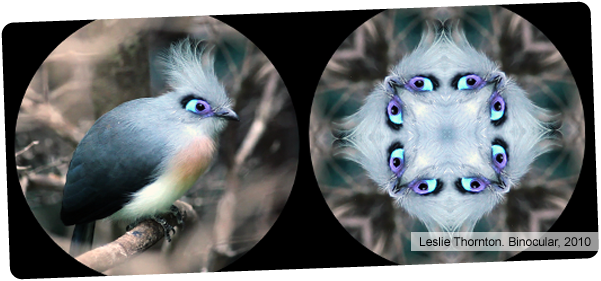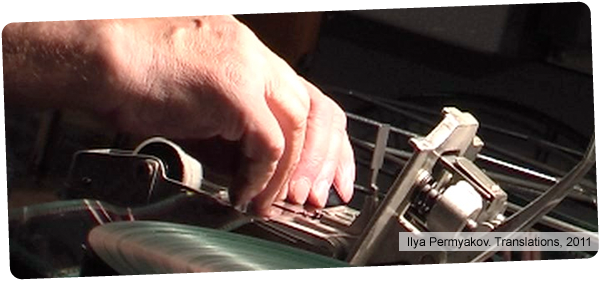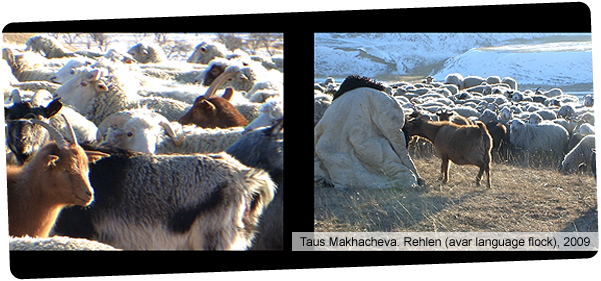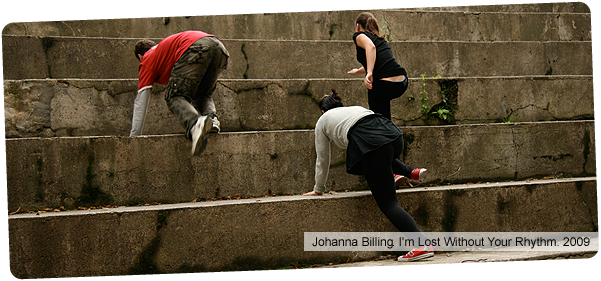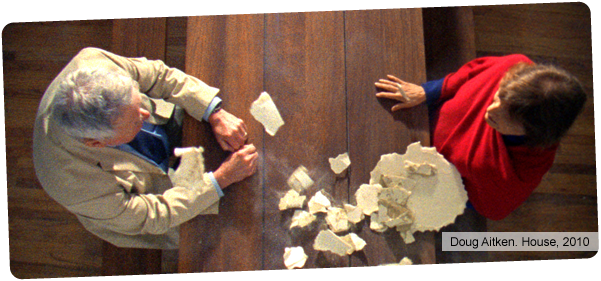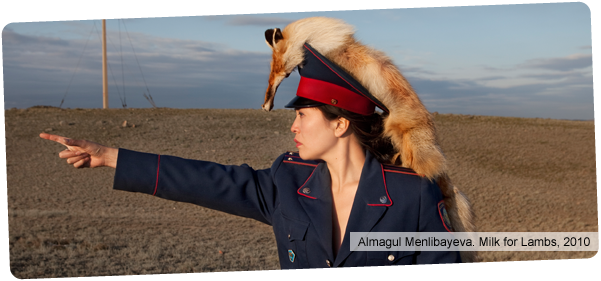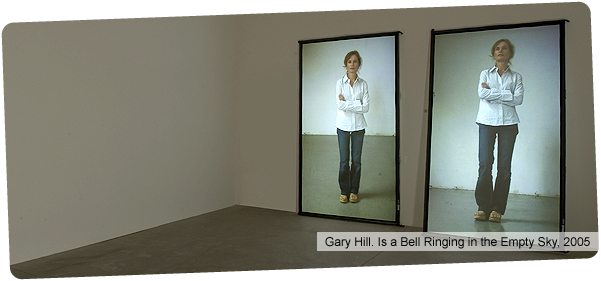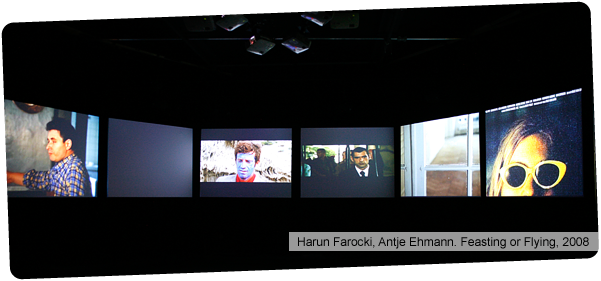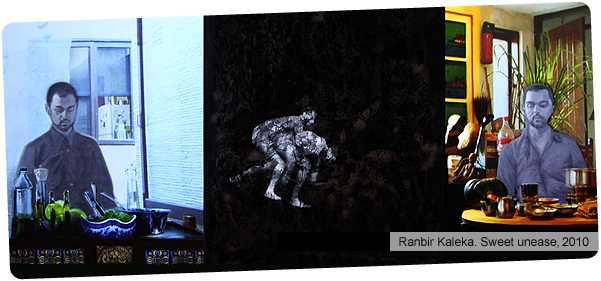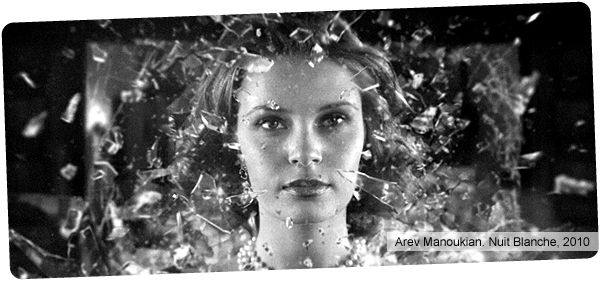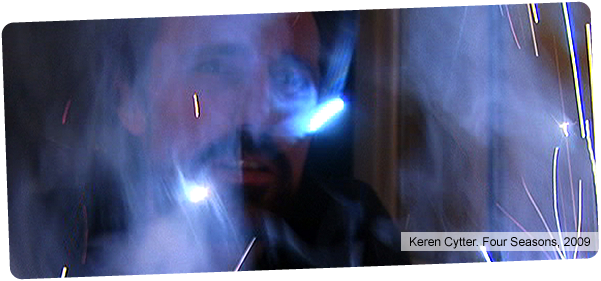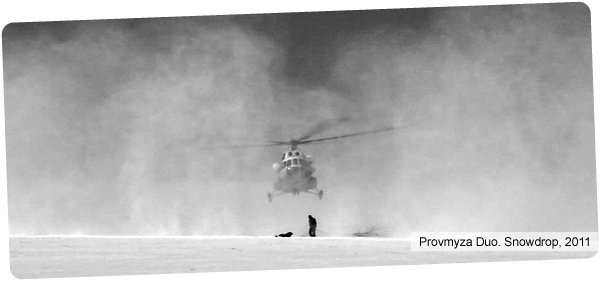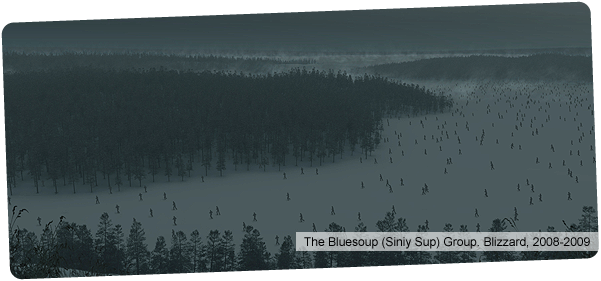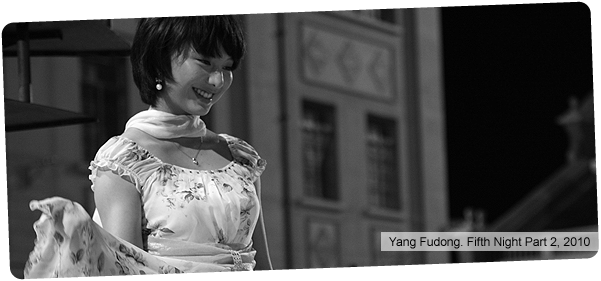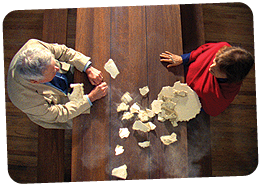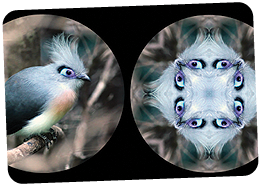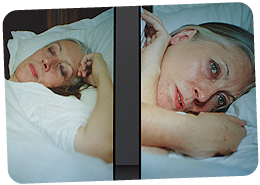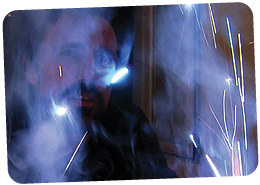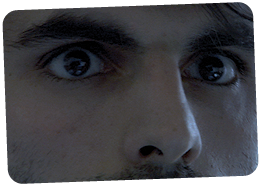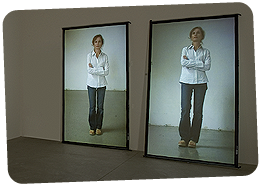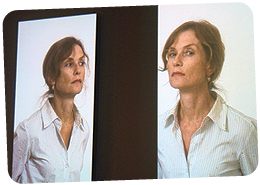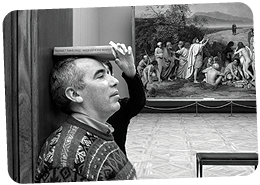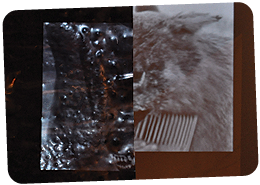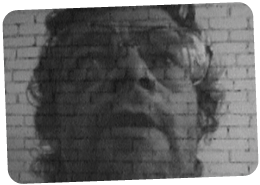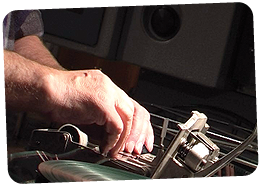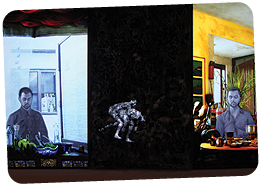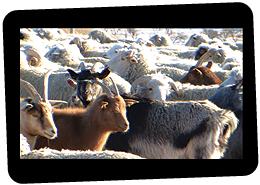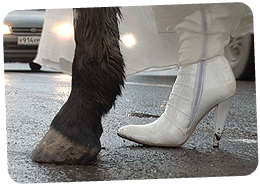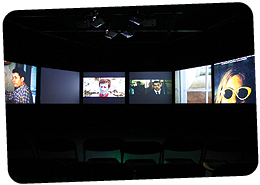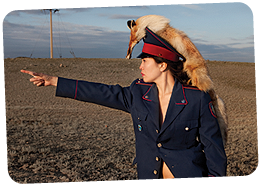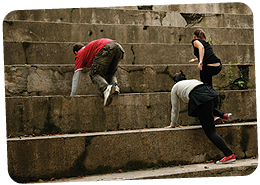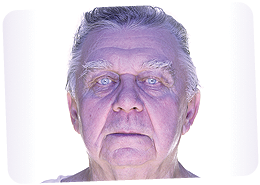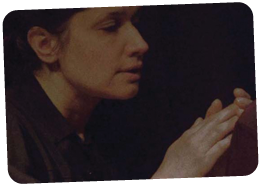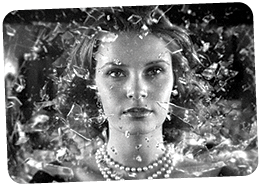About Media Forum

News

Programme
Programme at the Moscow Museum of Modern Art
Programme at the Garage Centre for Contemporary Culture

Schedule

Participants

Press

Partners
Expanded cinema exhibition. Part 1
Moscow Museum of Modern Art, June 15 — July 3 2011
Space of Memory/ Symbolic Journey
Video art can afford much of what is simply not done in traditional cinema: to break the narrative into several screens, to combine temporal currents moving with different speed in one image, to allow various styles to clash and interrupt each other, to combine materials of completely different nature seamlessly within a work.
House
2010
Single channel video, aspect ratio 4:3, 9'00''
Courtesy 303 Gallery, New York; Galerie Eva Presenhuber, Zürich; Victoria Miro Gallery, London; and Regen Projects, Los Angeles
“House” depicts the artist’s parents stoically seated at a table in a house, Aitken’s own, in fact. Facing one another, his parents’ gaze locked, debris and fragments of the house fall around them. The two protagonists remain untouched as the house crumbles and disappears, leaving only the demarcation of its shape in an empty lot that fades in the closing scene. Throughout the film, the apparatus of destruction is never shown. These devices become part of the film’s expanded narrative, implicating what happens outside the framed image.
“House” is exhibited as an installation shown on double monitors set in the midst of rubble and detritus. The spectator views the film surrounded by remains, becoming immersed in the fragments of what was once a home. Exploring themes of urban isolation and emotional alienation, House is a slow moving film that plays with memory and temporality.
Binocular
2010
HD video, «derived from the Binocular series», three edited loops, 8'00''
Courtesy of the artist
Binocular consists of a series of flat-screen monitors. On each screen two circular fields appear: on the left, images of animals — birds, reptiles, fish, mammals, some exotic, others familiar and commonplace — beautifully captured, filmed in the wild; on the right, the image is folded back on itself in a centripetal pattern, reminiscent of a kaleidoscope. The two circular fields are intimately connected: the movements of the animals on the left are remapped into the elegant mathematical abstraction on the right. The effect is unexpected and profound: the viewer notices minute tremors and shifts (a small heart beating, for example) in the left sphere, by catching the very same resonant motion, multiplied, recast, and folded into itself in the pattern on the right. There is no anthropomorphism here, no Disneyfied cuteness, no identification or domestication.
Thornton gives us a glimpse of a world prior to language and exterior to consumption, mute, opaque, and absolutely other. Leslie Thornton’s beautiful, meditative, camerawork locates the movements of predator/prey relations in the most subtle fragments and configurations of behavior and morphology. All of her work shares this intensity, an almost painfully precise focus on the fundamental minutiae of being in the world. In Thornton’s magnum opus, Peggy and Fred in Hell, for example, the tumultuous cacophony of post-apocalyptic litter surrounding her protagonists (two small children) was animate, threatening, epiphanic, and it was inescapable, because as viewers we were carried along into their world. There was just enough for us to make our way without being totally consumed (their own eventual heroic disposition saves Peggy and Fred, and rescues us). We are similarly transported by the succession of animal/animate spaces in Binocular. Nature is not subsumed or (re)produced, circumscribed or contained, so much as it is reflected, in a strange and elegant mirroring that acknowledges that the space of otherness traced in the image of the animal is filled by an abstract artifactuality, that in fact, there was nothing but an artifactuality present to begin with.
Fiona Tan, Netherlands/Indonesia
Rise and Fall
2009
HD installation, two channel, colour/stereo, 21'00''
Courtesy the artist, Frith Street Gallery, London and Wako Works of Art, Tokyo. Installation photos: Per Kristiansen
“Memory is a fold in the fabric of time” — says the artist. Born in Indonesia, she grew up in Australia and now lives in the Netherlands, where she became so famous that she represented this once strange country at the 53 Venice biennale. For this major port of commerce of the medieval Europe she created a video story of a boy who went east and travelled there for twenty five years — the Venetian merchant Marco Polo. Her colorful videos with many stage set become a meditation on her own identity of a “foreigner” and a declaration of a permanent subject — centuries-long history of relations between West and East. In her conversations with art critics she talks of the unstable interrelations between vision, memory and knowledge, of the untrustworthy eye, of contradictory relations between word and image, fact and fiction. In Rise and Fall the artist examines memory — the retrospective gaze and its relationship to the images we carry within ourselves. A double projection, the work shows us an older woman who is reminiscing about her life when she was still young. Memories of particular scenes or situations are triggered by everyday activities: bathing, walking in nature, getting dressed. The images move back and forth between present and past. In between these impressions we are confronted with footage of flowing, frothing, whirling water as a metaphor for the flow of memory, for becoming and passing.
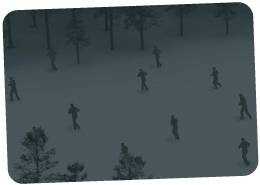 The Bluesoup (Siniy Sup) Group (Alexei Dobrov, Daniil Lebedev, Valery Patkonen, Alexander Lobanov), Russia
The Bluesoup (Siniy Sup) Group (Alexei Dobrov, Daniil Lebedev, Valery Patkonen, Alexander Lobanov), Russia
Blizzard
2008-2009
Video installation, 13'00''
Sound: James Welburn
Courtesy of the artists
BLIZZARD is a final part of the triptych (the other two are ECHELON and DEFENCE). These three works are united by a quasi-military subject and a common way of addressing the viewer. The viewer is seemingly involved into what is happening onscreen, it’s suggested to him to watch the action through the eyes of a casual witness of a certain mysterious operation or a spy who has to trace movements of cargo or manpower.
Essentially nothing is clear after the screening — the viewer/spy cannot guess the cargo’s quantity or its contents, or the direction of its movement (the ECHELON), the disposition of forces conducting some kind of a military operation in the fog is also uncertain (DEFENCE). Watching the people moving around in the snow (BLIZZARD) also poses more questions than it gives answers: who are all these people? Are they soldiers? Refugees? Sportsmen? Saboteurs? Where are they from and where are they going? Is it a deployment of forces? Is it a war at all?
Four Seasons
2009
16:9, digital video, colour/sound, 12'00''
Courtesy of SCHAU ORT
“The film Four Seasons opens with a neo-noir celebration of late-Hitchcock-meets-1980s-kitsch: a record plays dramatic music by Ferrante & Teicher; thick fake blood drips onto white tiles; snow whirls through the apartment and a lone woman climbs a dark, smoky staircase. Artist Lucy Stein plays the female lead as a wayward Hollywood beauty, clothed in a leopard print dress, teamed with a pink jumper, red lips pouting nonchalantly. ‘Excuse me, my name is Lucy, I’m living next door, second floor. I wanted to complain about the music, its stopped now but ...’. Lucy is confronted by a tall naked man, rising out of the bath as bubbles float across his upper thighs. Softcore porn enthusiasts might feel momentarily at home as this scene unfolds, but rather than a fast-track to the act of love, confused, the man starts calling for a woman named Stella. As the film unravels, conflicting narratives are revealed, switching between the stories of Stella, a tragic tale of heart-break and domestic murder, echoing Tennessee Williams’ A Streetcar Named Desire (1947), and Lucy. A voice-over describes the building using its architectural elements as metaphors for human behaviour. Climaxing with a series of spontaneously combusting objects — birthday cake, Christmas tree, record player — Four Seasons is a homage to all that is fake, showcasing visual clich’s, lo-fi special effects and deadpan delivery. Yet, somehow, Cytter creates a sense of poignancy rather than of cynicism. Cytter’s work emphasizes only multiple fragmented moments of feeling. As the man in Four Seasons explains to Stella, ‘I loved you then and I love you.’ Stella replies ‘... you pushed me. Head hit the floor so hard and my skull cracked wide open [...] You broke my back. My knees. My heart.’ Clearly he wasn’t in love with Stella at that point. Cytter flouts her style clashes — home-movie Hitchcock, lo-fi Hollywood glamour, soap-opera Samuel Beckett, soft-core feminism — manipulating these cultural tools with results that range from the banal to the sublime, from the embarrassingly comic to the vulgarly surreal”.
Kathy Noble in Frieze Magazine, Issue 123, May 2009
Moving Image/ Poetics of Language and Space
Some artists see moving images as a special communication system and start analyzing it from the point of contemporary linguistics and the very categories of language in which the image speaks to us.
Answer Me
2008
HD video/stereo sound 4'51''
Courtesy: Marian Goodman Gallery, New York, Gallery Hauser & Wirth, Zurich, London, Galerie Johnen + Schöttle, Berlin, Cologne, Munich, Galerie Chantal Crousel, Paris
“Answer Me” was shot in Teufelsberg, which means “Devil’s mountain” in German. It’s a very singular place, atop a hill made from the rubble of postwar Berlin, under which another building, a military-technical college designed by Albert Speer, is buried. During the cold war, a listening station was built on top of the hill to monitor Soviet and East German communications.
The film is based on a dialogue from a note that Michelangelo Antonioni wrote on the breakdown of a couple, where he wanted “to shoot not their conversation but their silences, silence as a negative dimension of speech”. A woman tries to end a relationship: “It’s over, admit it. That way everything will be out in the open and we’ll know what to do.” Her companion refuses to listen and plays the drums fiercely. She keeps on asking: “Answer me!” At times we hear it, at times we only see her lips phrasing it, her voice silenced by his drumming. Due to the echo produced by the geodesic dome designed by Buckminster Fuller, drumsticks resting on a vacant drum next to her, play to the echo of his drumming. The skin of the vacant drum vibrates and responds to the frequencies of his playing. Amplified by the dome, those frequencies cause the drumsticks to bounce creating not only an audible but also a visible echo. He refuses to listen and plays the drums blocking her voice from reaching him while at the same time “crossing” the space and coming close to her via those frequencies. In Answer Me, I was interested to bring Antonioni’s exchange under the physical influence of the building. Is it a monologue? Or is his drumming the other half of a dialogue, of which we only “understand” the part made of words?
Text:
“It’s over, admit it. That way everything will be out in the open and we’ll know what to do. It’s enough to know what we want. Isn’t that so? Answer me. Isn’t that right?”
Anri Sala
Is a Bell Ringing in the Empty Sky
2005
Two-channel video/sound installation, color/stereo sound, loop
Courtesy of the artist and Donald Young Gallery, Chicago
Together with the work entitled Loop Through, 2005, Is a Bell Ringing in the Empty Sky was originally produced for a retrospective tribute for the actress Isabelle Huppert. The work was recorded in high-definition video using a vertical format (the cameras were rotated 90 degrees). Two screens, each measuring approximately 96 h. x 54 w. inches, lean against the wall, one almost up against it and the other with a little more angle—suggesting something like a large dressing room in a photo or dance studio.
The two full-bodied images were recorded simultaneously and consist of Isabelle Huppert standing and looking at an invisible point positioned between the cameras. One camera looks down from a position slightly above the head and the other looks up from about thigh high. Huppert becomes a portrait in motion, fluctuating between “herself” and “acting,” where a rush of subtle changes of behavior and emotions are revealed: discomfort, intensity, boredom, playfulness, annoyance, agitation, coyness, etc.
Loop Through
2005
Two-channel video installation, color/silent, loop
Courtesy of the artist and Donald Young Gallery, Chicago
Together with another work entitled “Is a Bell Ringing in the Empty Sky”, 2005, “Loop Through” was originally produced for a retrospective tribute to the actress Isabelle Huppert. The work was recorded in high-definition video using a vertical format (the cameras were rotated 90 degrees), and is shown on two vertically mounted 40-inch (size variable) LCD monitors, reflecting the fact that Isabelle Huppert is filmed only from the waist up, rather than the entire standing figure. The monitors are positioned considerably apart to reflect the position of the cameras during the recording (in which the position of Huppert and the two cameras roughly formed an equilateral triangle). The person/actress is always looking at one or the other camera, sometimes turning her head to do so and other times simply shifting her eyes. This creates a triadic relationship between the viewer, Huppert, and, in a sense, her double. (In this respect, this piece is quite similar to a previous work entitled “Standing Apart/Facing Faces”, 1996.) As in “Is A Bell Ringing in the Empty Sky”, there are fluctuations between the ‘person’ and the ‘actress;’ however, the subtle presence of the ‘actress’ reveals itself to a greater extent in this work through facial expressions, in particular the eyes.
Paintings
2008
Running letters (scrolling text), 210 x 6 cm, chairs, limitless timing
Courtesy of the artist
"The installations look like a small cinema hall with a few rows of chairs, and a running letters panel instead of a screen. For more than five hours the text of Elder Philostratus’s book, Imagines is displayed by running letters. The book is a description of 64 paintings from a private collection in Naples, in fact the basic source on ancient painting. The scholars today are not sure if the paintings described have really existed or are just fictions. Artists from the Renaissance to 19th century academic art have used the compositions and subjects described in this book".
Yuri Albert
Yuri Kalendarev, Russia/Italy, Evgeni Yufit, Russia
The Silent Horizon
2011
Light, sound and the screen projection, 30'00''
Courtesy of the artists
In conventional cinema it is the sequence of images that is usually completed first. After this a composer is invited to make a sound track. In contrast to this for the “Silent Horizon” project a 30’ sound track was created first. This sound track consists of the field recordings of the night sounds at the sea and at the mouth of the river Arno, the phonogram of the sounds of the heart of the author, detected with the echo Doppler at the CNR, Pisa, which were after that overlayed with the sounds of the Sounding Screens.This sound track was then given to the St.Petersburg’s film-maker E.Yufit and a 30’ black & white video was produced by him.
An installation is based on the sound track, sounding screen and the contraposition of two echoed black & white light projections in between the monitor and the sounding screen.
The Sound Plates — Sounding Screens by Yuri Kalendarev, naturally generate sounds of a large range of frequency oscillations that allow multiple interactions with our being, through the phenomenon known as sonic entrainment. The Sound Screen does not continually generate sound. It exists as a sculpture, sort of object, an instrument, silent until played by the wind or a person. In this manner it requires, and possibly invites an action on the part of the viewer. In a way, those Sounding Screens are “devices” to listen to the silence. When an observer touching and moves the Sound Screen, its starts to vibrate and oscillate, more and more — and its producing a deep sounds which are growing, reverberating and reciprocally amplifying. What is exciting about these natural sounds is not only their remarkable sonic quality but also the enduring length of the sound which ranges from 1.5 to 5 minutes following a single hit given to the sound plate. The light projection of the image on the Sounding Screen begins to vibrate and rhythmically pulsate creating an almost hypnotic effect.
In redefining the concept of sculpture in pure sound terms, the work of Yuri Kalendarev extends and explores a new aural experience that goes beyond the sound itself, an investigation into the realm of “pure acoustic”. Perhaps the main feature of these sounding sculptures is that they take us beyond the limits of genre.
Beyond the music, beyond the sculpture, beyond the movie, beyond the language, beyond everything...
TOTART (Natalia Abalakova and Anatoly Zhigalov), Russia
Four Columns of Vigilance
2010/2011
6-Channel installation, 15'00''
Courtesy of the artists
Specially created for the Expanded Cinema project, this is a polyscreen version of the video performance “Four Columns of Vigilance”. This remake-research of a certain language adventure is unfolding on several levels. It re-actualizes the initial event, enriching it with real historical events connected with TOTART’s media projects and video performances. The voice-leading here is supported by word visualization, a special video poetry based on the main theme — life and development of literary examples for the 11 irregular verbs of the Russian language. Video project as a “transformer” is one of the principles of video work construction which allows the viewer to take a look inside TOTART’s “kitchen” (or the film set) and become a participant of this self-developing creative process.
Translations
2011
Audio-visual installation, looped image, linear sound, 24'20''
The sound was recorded and edited at the Boson Higgs Studio, Moscow
Music: Mikhail Kharitonov, female voice: Elena Liubarskaya, male voice: Ilya Permyakov
Courtesy of the artist
Two adjacent rooms bounded from each other. Two non-self-sufficient spaces. Screened video where the sound is muffled by noise, and text crystallizes and melts; and an invisible cinema from which only story, sound and characters remain perceptible. Translations between them, passing from one room to another. What is the result of these movements? A lost melodramatic thriller or its own travesty? A script telling us about the after-effects of a mimetic imitation of martyrs? An excuse to censure the narrative and to edit subtitles as a vers libre? This audio-visual installation is something in between a film and a book, but it sets itself the limits of its own pretensions to totality and wholeness. The image and sound in the work are not synchronized. The video is looped, closed upon itself. And the story is opened into a line with points of origin and finish. Finding oneself in the dark, putting on earphones the installation’s visitor gets an opportunity to turn on the disk with the imageless film and listen through this story.
The Third Cinema/ Video Art as a Cast from Reality
There is a division of cinema into feature film and documentary. And there also is video art exploring technology, formal catgories of its own existence and aestetitization of the signal. However, another objective by which video art defines its role in the world is the chronicle of art as a social movement against anything, documentation of social realities by artistic means, by radical performances with viewer participation.
Sweet unease
2010
Video projection on painted image, 11'11''
Courtesy of Volte Gallery Mumbai, India
Two men who are almost a replica of each other eat non-stop at the table and occasionally get up leaving behind them their painted selves on the canvas and meet on the wall where they engage in perpetual wrestling while taking on different personas, vacillating between genders and types, erotic touch and aggressive intrusion, engaging the self and the other. Simply put, food sustains life, and in this installation ‘eating’ is a metaphor for it and ‘wrestling’ the struggle with life’s questions.
He was a Good Man
2008
Video projection on painted image, 5'03''
Courtesy of Volte Gallery Mumbai, India
“In “He was a Good Man”, Kaleka revisits the patience, futility, stillness and wonder of ‘Man Threading A Needle’, made a decade before. In this recursion of a compelling psychic situation—the attempt to thread a needle is charged with the need to assert agency and suture the wounds of a harrowing inheritance—the artist gives himself the latitude to bathe the painted surface, not only with a corresponding if fluctuating portrait, but also with projected images that bear the freight of a traumatic history of migration and diaspora. At intervals, also, the painting is washed in the imageless light of the projector, harsh and inexorable as an inquisitor’s gaze.
Between projection and painting, in Kaleka’s work, the image-surface becomes the site of an acute, electrically unstable presencing. In attending to the precariousness of the image, its ontological indeterminacy, the probabilism attendant on its address to us and our reading of it, Kaleka invites us to reflect on startling questions about the nature of the individual subjectivity and the nature of everyday experience, with its not-always registered densities of choice, dream, reverie and delusion”.
Ranjit Hoskote
Rehlen (avar language flock)
2009
HD video, colour/silent, 7'21''
Courtesy of the artist
“The social dimension of my works resonates with personal history. Belonging to a Dagestan family I’m deeply familiar with habitual social reactions towards representatives of another culture. Understanding the difficulty of overcoming those differences continues to form the essence of my artistic practice. I often utilize irony and sarcasm in my works as I challenge the notion of ‘normality’ within social life and reveal the hidden controversies and fiction of the public politics towards cultural minorities.
I do not claim to document some kind of social crisis. Whilst capturing routine and ordinary situations my art manifests an obsessive symbolic element that subverts these seemingly innocuous moments and makes them available for an individual social response.
A work Rehlen is shot in between mountain villages Tsada and Ahalchi, Republic of Dagestan, it has a simple narrative: young man is wearing a traditional sheepskin coat Timug, that was usually worn by shepherds and attempts to scramble as close as possible to the flock of sheep. Literal interpretation of this work concerned with local nature or traditional cultural symbols, has a supportive function towards the content of the work- a question “What is the goal behind performers actions?”
Work Rehlen deals with problematics of social relations, that demand consent with certain rules and regulations for social and cultural integration. This work is about what we are ready to do in order to become a part of community? What choices do we need to make for this to happen!? Are we ready to wear a heavy and highly uncomfortable, from the perspective of modern man, clothes and get down on all fours?”
Taus Makhacheva
Sons of the Bitch
2011
Performance
Courtesy of the artist
Live performance, June 25 at 8 p.m. at Moscow Museum of Modern Art.
“For centuries the actor’s trade was considered to be shameful and actors were not interred in cemeteries along with the rest of community. It looks like the status and position of a Hollywood “star” today have to a large extent exonerated this ancient profession. Consider that the popularity of actors is such that the masses not only adopt them, discussing their private lives, but also imitate them! In my view the most curious change is in the aspect of meaning of this phenomenon. To act is to imitate life, reproduce its forms authentically, to dissemble, transferring the emphasis from the real content into the formal sphere (the actor’s technique, well-done make-up, grand costumes).
Imitating the actors, the audience at large has given up living its own life, started to playact it, cast as itself, to copy the permanently changing idols, reproducing dead images.
The reality of a blue screen is mixed with everyday life, infusing it with the colours of a festive cake or a whore. Having filmed absolutely all moments in the everyman’s lavatory life, leaving no intimate human sphere out of mass-media reach, the interactive television and reality shows have crowned this intervention. Now every manager, realtor or salesperson can imagine themselves a hero onscreen. This is the widescreen cinema that has consumed and transferred all the greatness of human soul into the flatness of the TV plasma.
The criterion of authenticity was long ago removed from the global scene, as Jean Baudrillard has stated many years ago in his definition of a simulacrum. An actor is not a self-sufficient figure. A puppet, beloved by the people, subject to the will of his director, producer and sponsor, she frequently makes excuses for herself in interviews — sorry, but that’s our profession: we play (well) bad guys in (bad quality) soap operas. What joy for the clerks of all kinds employed for life at alienating jobs to read this confessions!
The playacting technique today is simply indispensable in order to realize life-long dissimilation, that turns from self-deceit to self-destruction. It is no coincidence that every training course in achieving success primarily includes acting skills… It’s not entirely clear, though, who was it that ordered this global apocalypse called “widescreen cinema”?!”
Elena Kovylina
Harun Farocki, Antje Ehmann, Germany
Feasting or Flying
2008
6-Chanel video, 24'00''
Feasting or Flying, Harun Farocki/Antje Ehmann in Hebbel am Ufer Berlin © MuTphoto/Barbara Braun 2008
“The work Feasting or Flying refers to a basic statement that anticipates and explains the fundamental principle behind Farocki’s entire method of working with films: „Some dissect a bird in order to eat it, others in order to discover how to fly.“ Farocki and Ehmann made their video installation about film by putting together a selection of film sequences that present the act of suicide. Here they examine the shot/countershot technique, excerpt particular scenes and camera angels, and then edit them, compile them, and show them simultaenously on a kind of semicircular stage.
In this way they construct a setting for projecting the individual and the society, ideology and aesthetics, ficition and documentary. One after the other, carefully chosen and precisely identified sequences of selected suicides appear on the big screen, juxtaposing specific strategies of visualization or the aestheticization of suicide and its effects, or emphazising the part of films where suicide becomes the central theme of the moving image. The selected film narratives about suicide thus becomes the qualitative material for researching and constructing a complex social mosaic that offers us a comprehensive experience of film and suicide, of art and death”.
Igor Spanjol
Almagul Menlibayeva, Kazakhstan
Milk for Lambs
2010
Digital video, color/sound, 11'35''
Courtesy of Priska C. Juschka Fine Art
Menlibayeva stages and films complex mythological narratives In the Steppes of her native Kazakhstan, with references to her own nomadic heritage and the Shamanistic traditions of the cultures of Central Asia.
Her video, Milk for Lambs, explores the emotional, spiritual and cultural residues of an ancient belief system, still resonating among the peoples of Central Asia today — the Tengriism (sky religion) of the Turkic tribes, reaching from Eurasia to the Pacific Ocean.
The mythological nurturing Earth Goddess Umai and favorite wife of Tengri, the god of the sky, symbolizes the close relationship of the people to the land and its given riches, by animals and humans feeding off her body and drinking her milk. The female descendants of Umai invoke and continue a precarious symbiosis today- between the nurturing child- mothers and their insatiable, adolescent men.
I'm Lost Without Your Rhythm
2009
DVD, loop, 13'29''
Johanna Billing, I'm Lost Without Your Rhythm, 2009, photo Lavinia German, courtesy of the artist and Hollybush Gardens, London
Johanna Billing’s videos reflect on routine, choreography and ritual, with an emphasis on the fragility of individual performance within collective experience. Obsessed by circularity and retrospection, she stages specific situations where something is about to take place, the artist herself remaining invisible during the performances and actions that are recorded. Billing’s skill lies in combining the choreography of individuals with facilitating their freedom to perform naturally, bringing the whole together in the editing process.
I’m Lost Without Your Rhythm is based on the recording of a live performance of dance ‘learned’ or performed by amateur Romanian dancers in Iasi, Romania, during the Periferic 8 Biennial of Contem- porary Art in Oct 2008. The film links several days’ activity into a continuous process, in which dancers were watched by an audience who were free to come and go as they pleased. There is no final performance as such and so the work is a result of collaboration between choreographer, musicians, dancers and audience.
Simulated Reality/ The Other Hero
It may seem that video artists are sure: social reality is a closed interactive installation, and there is nothing beyond the screen. As fits the artistic avant-garde they strive to break out through into the real life, breaking the cinema stylistics of the 1950’s by contemporary special effects, creating a storm with rotating blades of a helicopter. Video art today is inventing a new hero for itself, one who would be not a viewer, who will tell new stories at the intersection of image and sound.
No Cure
2007
4-Channel Video Installation, 4:3 Pal DVD, loop, 14'15''
Score by David Chisholm. Lyrics: Robert Smith/ Laurence Tolhurst/ Simon Gallup
© by Fiction Song Ltd., Musik-Edition Discoton GmbH
Courtesy of BMG Music Publishing Germany
Courtesy of the artist
Based on the structure of karaoke, “No Cure” features four 80-year-old Germans, singing the lyrics of three The Cure -songs: Cold, One Hundred Years and Sinking. As the electronic score composed by Melbourne composer David Chisholm uses leitmotifs of Richard Wagner’s opera “Gotterdommerung” (“Twilight of the Gods”) to accompany the lyrics, the work drifts into a poetic and eerie comment on the transience of life and memory.
“Vot” (So)
2010
HD video, colour/sound, 5’24’’
Courtesy Regina Gallery, Moscow/London
A group of five actors performs a vocalise, formed by speech. Synchronization — a moment of harmony in this “speech” happens when the Russian word vot is pronounced, or its vocalise double — a length of singing similar in musical and compositional logic to “vot”.
The work was realized in Toulouse with French actors.
PROVMYZA Duo (Galina Myznikova & Sergey Provorov), Russia
Snowdrop
2011
HD video, b&w/stereo sound, 30'50''
Courtesy of the artists
“Human beings are able to distance themselves from their immediate environment and perceive the world as something bigger than self. A man has been gifted with vision as an act connected to remoteness, to distance, as the point of view turns from multiple and close to a united remote world view like painting of “packed space” turns gradually into painting of the “empty space”. It is important to squint in order to see better the demonstrated tragic picture of the world. The thinline of the leash, connecting dog and man, appears and disappears from view, defining the fragility of their relationship and preceding their break-up. The helicopter jarring with nature in a split second tears apart the connection between the dogand the man. Its powerful energy field is vested with a specific performative task — to destroy the harmonious architectonics of the natural state. Formally it forms the individualized space of a snowstorm as some special place with its own history and simultaneously creates a special and temporal border between the calm of nature and an artificial chaos (blizzard). The polyphonic interweaving of natural, human and technological images creates the principle of defamiliarization (ostranenie), of combining the incongruous, of incommensurability of logical, sensual andchaotic thinking”.
Galina Myznikova & Sergey Provorov
Nuit Blanche
2010
digital video, colour/sound, 4'41''
Courtesy of Stellar Scene and SpyFilms
A dramatic short film, Nuit Blanche explores an experience many of us have lived before — a fleeting yet powerful connection with a perfect stranger. Set in a dark cobblestone street in the 1950’s, a man catches the gaze of a woman in a cafe across the street. This split-second moment becomes suspended in time, as the two gravitate towards each other in a hyper real fantasy where nothing can hold them back.
“An unforgettable moment with a stranger happens to everyone, especially in a large metropolitan city. It lasts for a split second and then things get awkward so we turn away. I wanted to take that moment of attraction and stretch it in a hyper-real fantasy where things unfold like slow moving photographs. I wanted to create something beautiful within the clich. It is a daydream put on film that turned out exactly how we imagined it.
The actors in Nuit Blanche were shot in a green screen studio in Toronto. All the street environments and sets were created digitally in post-production with matte paintings of still photographs taken in Paris and Toronto. Pre-production took a few months of parttime work as we created an animated pre-viz and did numerous visual effects tests. The challenging part was that we had to create almost everything. There was a huge volume of assets, from wet streets to 3d leaves and cars to make. But the hardest was trying to figure out how the main effects should look. After breaking real glass at over 2000 frames per second on set we realized that it will never look the way we want. We had to create and animate the glass in 3d. The visual effects took about 8 months of work with Marc-Andre Gray as the main visual effects artist. It was a grueling process but it was a pleasure to do because we were very passionate about the project”.
Arev Manoukian
The Moscow Museum of Modern Art
Yermolaevsky lane, 17
http://www.mmoma.ru/


